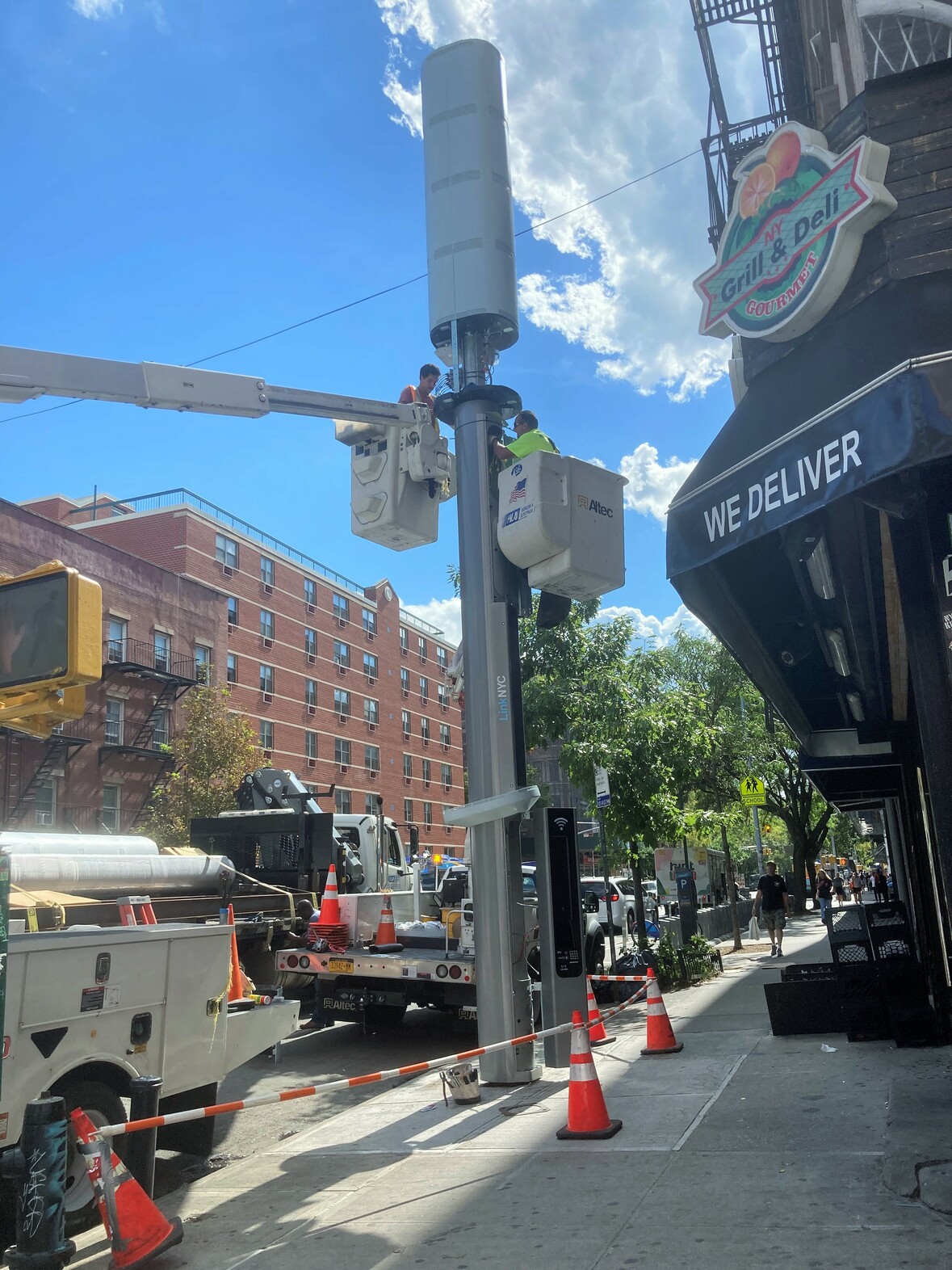BY LINCOLN ANDERSON | The city’s contentious rollout of 5G street megatowers is facing a new setback after the federal government mandated that the scheme must go through additional layers of review.
After weeks of prodding by Congressmember Jerrold Nadler, the Federal Communications Commission recently wrote to CityBridge, the private consortium the city has contracted with to install 2,000 of the 32-foot-tall towers. About one-third of the sci-fi-looking structures are slated to be erected in 13 “equity districts” around the city, including the East Village and Lower East Side. But there has been pushback from various parts, especially from areas including historic districts, such as Greenwich Village, where nine of the towers are initially planned and where earlier this year Community Board 2 called for a moratorium on the new infrastructure’s rollout. Parts of Brooklyn have seen opposition, as well.
Greenwich Village residents turned out in force at the community board at the end of last year to declare they don’t need or want the monoliths, which they slammed as unsightly eyesores. Some also have concerns over the safety of 5G millimeter-wave, non-ionizing, electromagnetic radiation, said to be 100 times more powerful than 4G.
Yet, despite saying it would first consider input from C.B. 2, in February the city’s Office of Technology and Innovation plowed ahead with work on two 5G tower sites on Washington Street — before local politicians repeatedly protested, causing the work to grind to a halt.
In his April 20 letter, Garnet Hanley of the F.C.C.’s Competition & Infrastructure Policy Division, informed Robert Sokota and Margaux Knee, CityBridge’s respective president and general counsel, that a so-called Section 106 review is required for the project.
“…[T]he Link5G program falls within the scope of the Commission’s rules for implementation of the National Historic Preservation Act (NHPA) and the National Environmental Policy Act (NEPA),” Hanley stated. “Prior to construction [of the 5G towers], CityBridge must complete the Commission procedures implementing the historic preservation review process pursuant to Section 106 of NHPA as set forth in the Nationwide Programmatic Agreement for Review of Effects on Historic Properties for Certain Undertakings Approved by the Federal Communications Commission…and the environmental review process pursuant to the Commission’s rules implementing NEPA.
“Accordingly, we expect that CityBridge will comply with these rules before constructing additional Link5G tower kiosk[s],” the letter notes.
For those towers that have already been constructed, the city must conduct “a post-construction review pursuant to…Section 106,” the letter says.
At the same time, Hanley said the F.C.C. backs the 5G rollout: “We support the efforts behind this project to close the digital divide… .”
Section 106 requires a review of any federally licensed or funded project that might negatively impact a historic district or any individual landmark listed on the National Register of Historic Places. The review reportedly must include any 5G towers located adjacent to historic districts or any individual landmarks, as well as towers sited within historic districts. Furthermore, the review must study the cumulative impacts of all the towers currently proposed, along with those that might be proposed in the foreseeable future.
West Village activist Zack Winestine, who heads the group Save Gansevoort and has been closely monitoring the 5G towers installation, hailed the F.C.C.’s intervention.
“This is great news,” he said. “In the past, the city has boasted that these intrusive three-story-tall towers would be subject to review by community boards and the borough president, and then completely ignored those reviews when they concluded the project would have serious negative impacts and should be paused. Now, finally, there will be an opportunity for public review of the impacts of these huge structures on the streetscapes within and surrounding our historic districts, and the city won’t be able to ignore the results.”
Frampton Tolbert, the executive director of the Historic Districts Council, said his organization was also heartened by the development.
“H.D.C. is pleased that the F.C.C. has found that the proposed installation of Link5G tower kiosks requires a Section 106 process under the National Historic Preservation Act (NHPA),” he said. “This will allow stakeholders from across the city to weigh in on the placement and appropriateness of the towers, especially within designated historic districts and immediately adjacent to individual landmarks. Stakeholders have been concerned to see installations already happening over the past several months with little to no public input.”
Village Preservation, which has also been a watchdog on the issue, praised the decision — but said their pushback won’t stop.
“Any tower proposed for a historic district or landmarked site will still have to go through the city’s public review process via the Landmarks Preservation Commission,” the organization noted in an e-mail blast. “However, we don’t yet know what that process will look like or how the appropriateness of the proposed siting will be evaluated. The city’s rollout of this program has been haphazard and inconsistent, and involves contradictory statements about where towers would go and why. We continue to push back on the need for and appropriateness of many of the proposed installations.”
An O.T.I. spokesperson did not respond to a request for comment.
There is no mandated timeline for the actual Section 106 process. They reportedly usually take at least several months to complete, sometimes longer. It’s also unclear if the review would be for the entire city, or district by district. One source predicted the process could last six months to a year. CityBridge and O.T.I. will need to prepare their presentations, set times for hearings to take place and times for public comment and review.


Mistake.
It’s going to turn out these towers will be the silent killers in our neighborhoods. You know it’s the case because of the blind rush to put them up. In Chinatown, next to the landmark Forward Building, one of these three-story towers stares into a bedroom a few feet from the window. We’re all going to fry — and maybe that’s the idea?